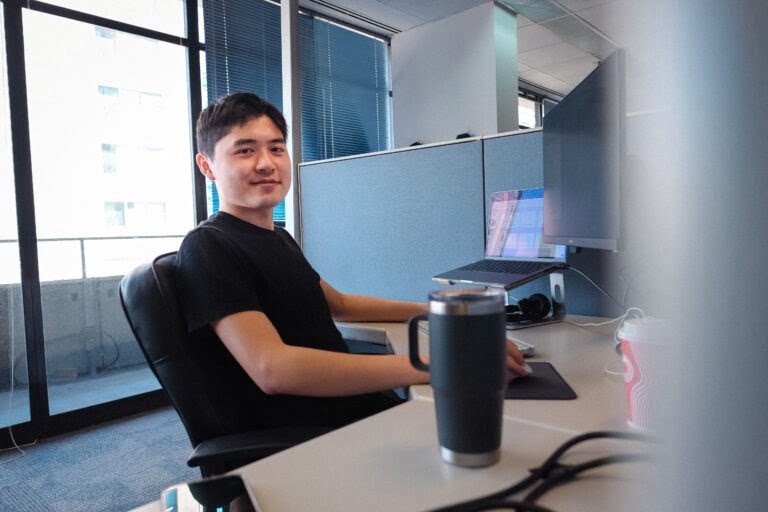
VoltSafe Blog Team – April 11, 2024
Get To Know: Stanley Cheung, Full Stack Engineer, Game Developer & All-Around Nice Guy
When Stanley Cheung, VoltSafe’s Full Stack Development Engineering Co-Op, was looking for a company to host his first co-op experience, he thought the best place to start would be checking out all the websites of the potential host companies. After reading about the opportunity on UBC’s job board he headed over to Voltsafe’s website and liked what he saw. He was drawn to the company’s mission to innovate on the electrical plug and enjoyed the unconventional take on staff biographies. It conveyed to him that working for the company would present the fun and welcoming environment he was looking for. As a Full Stack Developer he was also impressed by the clean and modern presentation of the website which was fitting for a tech company.

Stanley has already developed websites for his own personal interest, mainly focusing on retro arcade games like Snakes and Ladders. He learned about the role of a Full Stack Web Developer in high school, which eventually led him to major in Computer Science. Full Stack Web Developers work with a variety of different technologies from designing user interfaces to building web servers. If you didn’t already know, the web development community is large and supportive and offers tools shared amongst developers for free. Stanley uses these tools to assist him in his current projects.

Currently working on building an internal dashboard for VoltSafe to be utilized by all staff members from marketing to engineering and customer support, Stanley has been given full control of the development of VoltSafe’s internal dashboard. Building a dashboard from scratch offers the company a myriad of possible features that can be included in the final product as opposed to purchasing a ready made, commercialized dashboard. It also offers Stanley the opportunity to be a part of the initial decision making process that goes into building out a customized dashboard for company staff members. He finds the decision making process the most interesting part of the job. It all starts with meeting with staff members to learn about what they would like to see in an internal dashboard system and what they would find most useful or helpful in assisting with their daily tasks. Once a list of requested features is compiled then the next thing would be to go through the list to figure out what the most important features would be out of that list to create an efficient dashboard.

The most challenging part of building a dashboard for a startup is the limited resources that are made available to the developer. So Stanley enlists the help of his mentor VoltSafe’s Back End Engineer, George Al-Haddad, to provide feedback and offer insights and tips on how to approach such a daunting task within the short time frame offered with a co-op experience. It’s perhaps one of the most important takeaways for Stanley. Coming from an educational environment, Stanley was used to spending a few days on reading and research before jumping on a project. George suggested that a better way to take advantage of the short time he was provided by the company to complete the task would be to jump in and take on the project by doing rather than just thinking or planning. George shared that problems are best solved by just facing it head on. According to George, “Too much preparation is just procrastination.” Just attack the problem head on and pick up what you need to learn along the way. In other words, “Just Do It”.
Stanley shared that George’s tip will definitely prepare him for the expectations of the work world where so often you are expected to start working without the luxury of time to prepare. It’s giving yourself the opportunity to try something and see if it works. If you fail, then you learn from that experience and continue building on what you learned from it. This allows engineers to increase their productivity and output within the tight deadlines and time constraints placed on the project. Stanley has also learned from George that there are trade offs with every engineering decision. It’s important to consider the pros and cons of each decision and put thought into every line of code you write. Each line of code should have a purpose for being there. Keep things simple and don’t over complicate your code writing.

Tashfiq Alam, the UX Design Lead at VoltSafe, has taught Stanley that the key to designing a good user interface is reducing the cognitive load on the customer. This essentially means that to avoid overwhelming your customer or clients, you will want to keep things visually simple by reducing the number of features presented on a page. These are tips that he feels will provide him with a leg up on his peers.

When not designing gaming sites, Stanley relaxes by watching movies by directors like Christopher Nolan, Werner Herzog and Quentin Tarantino. He admires Tarantino’s ability to have complete creative control over his projects. He also enjoys the director’s use of dialogue that injects humour that can seem out of place. It provides a peek into the everyday life of the character. He also likes the scoring choices which have created memorable and iconic scenes which audiences take away with them. You could say that Tarantino works a lot like a Full Stack Web Developer in an environment where he is given full control and responsibility over his creation.
If you would like to find out what it is like to have creative control of a project and learn in a supportive environment, then head over and check out our careers page.
About VoltSafe Inc.
VoltSafe Inc. is changing the way people connect to power. Headquartered in Vancouver, BC, the Canadian tech startup has reinvented the electrical plug by eliminating prongs, adding magnets and an “electrical fingerprint”. Using patented technology, VoltSafe has created the world’s safest, simplest, and smartest plug design since electricity came into homes more than 140 years ago. The company’s product pipeline includes magnetic plug replacement solutions for household, commercial, industrial, marine, electric and autonomous vehicles, emergency services, data centres and more.